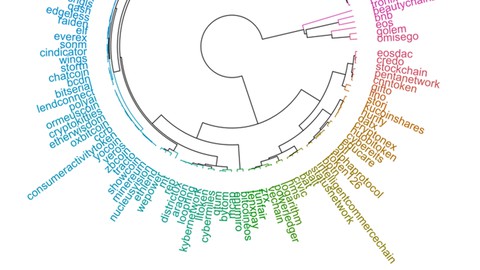
Data Science on Blockchains
Data Science on Blockchains, available at $54.99, has an average rating of 4.21, with 43 lectures, 16 quizzes, based on 7 reviews, and has 64 subscribers.
You will learn about Learn how the blockchain technology, Web3 and decentralized finance works Learn to parse the data from Bitcoin and Ethereum to develop machine learning models on the data Mine blockchain data for price prediction Mine blockchain data for ransomware payment, darknet market payment and pump/dump scheme detection Track investor behavior on multiple DeFi networks on Ethereum This course is ideal for individuals who are Data scientists or Machine learners or Graduate students or Blockchain analysts or Blockchain engineers It is particularly useful for Data scientists or Machine learners or Graduate students or Blockchain analysts or Blockchain engineers.
Enroll now: Data Science on Blockchains
Summary
Title: Data Science on Blockchains
Price: $54.99
Average Rating: 4.21
Number of Lectures: 43
Number of Quizzes: 16
Number of Published Lectures: 43
Number of Published Quizzes: 16
Number of Curriculum Items: 59
Number of Published Curriculum Objects: 59
Original Price: $39.99
Quality Status: approved
Status: Live
What You Will Learn
- Learn how the blockchain technology, Web3 and decentralized finance works
- Learn to parse the data from Bitcoin and Ethereum to develop machine learning models on the data
- Mine blockchain data for price prediction
- Mine blockchain data for ransomware payment, darknet market payment and pump/dump scheme detection
- Track investor behavior on multiple DeFi networks on Ethereum
Who Should Attend
- Data scientists
- Machine learners
- Graduate students
- Blockchain analysts
- Blockchain engineers
Target Audiences
- Data scientists
- Machine learners
- Graduate students
- Blockchain analysts
- Blockchain engineers
Bitcoin cryptocurrency and the Blockchain technology that forms the basis of Bitcoin have witnessed an unprecedented attention. As Blockchain applications proliferate, so does the complexity and volume of data stored by Blockchains. Analyzing this data has emerged as an important research topic, already leading to methodological advancements in the information sciences. Although there is a vast quantity of information available, the consequent challenge is to develop tools and algorithms to analyze the large volumes of user-generated content and transactions on blockchains, to glean meaningful insights from Blockchain data. The objective of the course is to train students in data collection, modeling and analysis for blockchain data analytics on public blockchains, such as Bitcoin, Litecoin, Monero, Zcash, Ripple, and Ethereum.
Expectations and Goals
We will teach all core blockchain components with an eye towards building machine learning models on blockchain data. Students will be able to achieve the following learning objectives at the completion of the course.
-
Learn the history of digital currencies and problems that prevented their adoption. What are the real-life use cases of Blockchain? How Blockchain differs from earlier solutions?
-
Learn the concepts of consensus and proof-of-work in distributed computing to understand and describe how blockchain works.
-
Learn data models for addresses, transactions and blocks in cryptocurrencies and Blockchain platforms.
-
Use Java Python and R to extract blockchain blocks and store the transaction network on Bitcoin, Ripple, IOTA and Ethereum blockchains.
-
Model weighted, directed multi-graph blockchain networks and use graph mining algorithms to identify influential users and their transactions.
-
Predict cryptocurrency and crypto-asset prices in real time.
-
Extract and mine data from smart contracts on the Ethereum blockchain.
We would like to thank Ignacio Segovia-Dominguez of UT Dallas and Nasa for his help in editing and providing feedback on the course content.
Course Curriculum
Chapter 1: Origins and Consensus
Lecture 1: Origins of Digital Currencies
Lecture 2: Networks, Traditional Consensus
Lecture 3: Nakamoto Consensus
Lecture 4: Tenets of Bitcoin
Chapter 2: Bitcoin: the first Blockchain
Lecture 1: Hash Functions and SHA256
Lecture 2: Address, Transaction, Block and Output
Lecture 3: Transaction Fee, Change Address, Address Reuse and Merkle Tree
Lecture 4: Transaction Creation, Forks
Lecture 5: Forks in the Transaction Network
Lecture 6: Proof-of-work, Block Mining, Rewards
Lecture 7: Proof-of-X: Alternatives to POW
Lecture 8: Mining Pools
Lecture 9: Output Types
Lecture 10: Wallets
Lecture 11: The Script Language and Locking/Unlocking Scripts
Lecture 12: Forks in the Protocol
Lecture 13: Segregated Witness and Taproot/Schnorr
Chapter 3: Ethereum: the World Computer
Lecture 1: Ethereum Fundamentals
Lecture 2: Ethereum Addresses, Account Nonce
Lecture 3: Smart Contracts, Capabilities and Life Cycles
Lecture 4: Ethereum Transaction Types
Lecture 5: Gas Cost, Gas Price and Gas Fee
Lecture 6: Ethereum Data Storage: Stack, Memory and Storage
Lecture 7: Transaction and Message Call, Logs and Events
Lecture 8: ETHash: the POW mining for Ethereum until 2022
Lecture 9: Ethereum Block Header, Patricia-Merkle Tree, Block Gas Limit and Size
Lecture 10: Web3, DAO, dApps
Chapter 4: Decentralized Finance
Lecture 1: Decentralized Finance Primitives
Lecture 2: ERC20, ERC721, ERC1155 Tokens
Lecture 3: Stablecoins
Lecture 4: Oracles
Chapter 5: Graph Structures of UTXO Blockchains
Lecture 1: UTXO Transaction Network and Three Graph Rules
Lecture 2: Address and Transaction Graphs
Lecture 3: UTXO Chainlets: Merge, Split and Transition Chainlets
Chapter 6: Graph Structures of Account Blockchains
Lecture 1: Transaction Networks on Account-based Blockchains
Lecture 2: Transaction Networks of ERC20 and ERC721 (NFT) tokens
Lecture 3: Networks of Smart Contract Transactions and Calls
Chapter 7: E-Crime on Blockchains
Lecture 1: Darknet Markets
Lecture 2: Ransomware
Lecture 3: Obfuscation: Peeling Chains, Coin Mixing, Shapeshifting
Chapter 8: Temporal Data Mining on Blockchains
Lecture 1: Network Snapshots, Address and Transaction Features
Lecture 2: Transaction Fingerprinting
Lecture 3: Training a Classifier on a Temporal Window, Performance Metrics
Instructors
-

Cuneyt Gurcan Akcora
Professor of Computer Science and Statistics -

Murat Kantarcioglu
Professor of Computer Science at Univ. Texas at Dallas -

Yulia Gel
Professor
Rating Distribution
- 1 stars: 0 votes
- 2 stars: 1 votes
- 3 stars: 1 votes
- 4 stars: 2 votes
- 5 stars: 3 votes
Frequently Asked Questions
How long do I have access to the course materials?
You can view and review the lecture materials indefinitely, like an on-demand channel.
Can I take my courses with me wherever I go?
Definitely! If you have an internet connection, courses on Udemy are available on any device at any time. If you don’t have an internet connection, some instructors also let their students download course lectures. That’s up to the instructor though, so make sure you get on their good side!
You may also like
- Digital Marketing Foundation Course
- Google Shopping Ads Digital Marketing Course
- Multi Cloud Infrastructure for beginners
- Master Lead Generation: Grow Subscribers & Sales with Popups
- Complete Copywriting System : write to sell with ease
- Product Positioning Masterclass: Unlock Market Traction
- How to Promote Your Webinar and Get More Attendees?
- Digital Marketing Courses
- Create music with Artificial Intelligence in this new market
- Create CONVERTING UGC Content So Brands Will Pay You More
- Podcast: The top 8 ways to monetize by Podcasting
- TikTok Marketing Mastery: Learn to Grow & Go Viral
- Free Digital Marketing Basics Course in Hindi
- MailChimp Free Mailing Lists: MailChimp Email Marketing
- Automate Digital Marketing & Social Media with Generative AI
- Google Ads MasterClass – All Advanced Features
- Online Course Creator: Create & Sell Online Courses Today!
- Introduction to SEO – Basic Principles of SEO
- Affiliate Marketing For Beginners: Go From Novice To Pro
- Effective Website Planning Made Simple




















